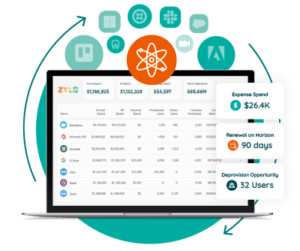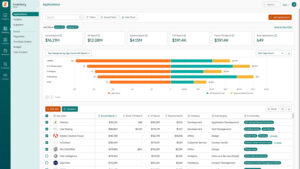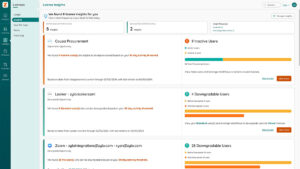Table of Contents
Do you ever feel like you spend more time looking for the right data than taking action? This is an all-too-common sentiment we hear from IT, Procurement, and SAM leaders. You just want to get to the good stuff – the strategic work that’s actually going to move the needle. That’s why SaaS data management is a critical first step in SaaS management.
Read on for the importance of good SaaS data management and six tips to set you up for success.
What Is SaaS Data Management, and Why Is It Important?
SaaS data management is a shared responsibility between the provider (who manages the hardware and software) and your IT department (who manages the application’s administration in-enterprise). It involves tracking your SaaS inventory, observing data usage and SaaS contract data policies, and tracking SaaS provider data usage.
SaaS data management is integral to in-house SaaS Management, software optimization, program alignment throughout the organization, and ensuring compliance with data regulations and security policies. If you can catalog your company’s SaaS data effectively, you can unlock many benefits while also preventing the potential costs and security risks of poor management.
The No-BS SaaS Management Playbook
Learn MoreHow Poor SaaS Data Management Impacts Your Business
You might be wondering, “What are the potential risks of poor SaaS data management?” Well, to summarize a multi-faceted problem, poor SaaS data management means:
- You don’t know all the apps in your SaaS stack, how much you’re spending, who owns them, and how well they’re being utilized and adopted.
- You can’t make smart optimization and renewal decisions.
- You are effectively auto-renewing applications because you aren’t actively monitoring them, which means you are likely overpaying and have more licenses than you need.
- You are taking unknown security and compliance risks.
- It hinders progress on company initiatives, like reducing operating expenses, improving your security posture, innovating company apps, and more.
The risks and harm of poor SaaS data management are many and dangerous. These alone have probably convinced you of the importance of SaaS data management. But, let’s look at the potential benefits of proper data management and how you can use SaaS management platforms to unlock them fully.
Benefits of a SaaS Management Platform for Data Management
One of the main benefits of good SaaS data management is simply avoiding the many risks of not having it. But there are other things to be gained from having a good view of your SaaS data. These benefits can happen without a SaaS management platform, but these platforms often reduce risks even further while increasing benefits, so let’s take a look at what they can do.
SaaS Discovery and Inventory
 SaaS data management is all about visibility, and SaaS management platforms are built to provide you with key SaaS discovery and inventory tools. By having a system of record for all your SaaS applications, you have a centralized source of truth regarding data, renewals, and license inventories.
SaaS data management is all about visibility, and SaaS management platforms are built to provide you with key SaaS discovery and inventory tools. By having a system of record for all your SaaS applications, you have a centralized source of truth regarding data, renewals, and license inventories.
SaaS License Management
SaaS management platforms are key to measuring SaaS usage, maximizing license efficiency, and driving adoption—all of which are integral points of measurement in SaaS data management. This allows you to revolutionize your SaaS license management and optimize your costs and efficiency.
SaaS Renewal and Spend Management
Because SaaS management platforms give you the edge on data management, you can optimize your SaaS renewal and spend management. This lets you reduce your software costs and add cash to your bottom line.
SaaS Security and Governance
One of the crucial aspects of SaaS data management is improving security and governance, and SaaS management platforms improve your ability to do so greatly. With a platform, you can fend off security threats and compliance disasters to improve employee experiences and company integrity.
6 Tips to Achieve Good SaaS Data Management
Now that you know the risks of poor SaaS data management and the benefits of good management, how do you achieve the best SaaS data management possible? We’ve compiled the six best tips for SaaS data management that we’ve observed over the years across countless clients.
Tip #1: Create a Strategy
First, you need to have a strategy for SaaS data management. By defining your business goals and how SaaS management supports them, you can understand exactly what you seek from your SaaS data.
Your strategy should cover a few critical aspects of your data management. Know your primary goals for visibility and optimization, what tools you plan to use/need to acquire for data management, and where you want to start with implementation.
Tip #2: Establish a SaaS System of Record
Having a central source of truth for all of your SaaS data is a crucial strategy used by enterprises with the best data management. A system of record for your SaaS data means you have one place to check all things SaaS, which gives you full visibility and allows you to focus on optimization.
Many organizations today use a spreadsheet as their source of truth. But, it comes with many drawbacks. Besides a ton of manual work for you, it’s quickly out-of-date, prone to errors, and isn’t a complete picture of your SaaS landscape.

To establish a central source of truth, we recommend following these steps:
- Determine what you will use for your system of record, like a SaaS management platform.
- Compile all of your contract data.
- Integrate your SaaS apps for deeper utilization data.
- Assign application owners so you have systems of accountability.
Tip #3: Ensure Employees Are Informed
Once you have your SaaS data compiled in your system of record, you need to ensure employees understand the value of SaaS management. For example, if it’s known that the company has an operating expense reduction target, share how SaaS management helps achieve that goal.
Further, for those more intimately involved in the day-to-day, help them understand the importance of SaaS data management and maintaining an up-to-date system of record for SaaS. Good data hygiene begets effective SaaS management.
Tip #4: Give Visibility to Stakeholders
Identify the key stakeholders of your SaaS management program. Typically that includes IT, Procurement, SAM, and Finance. Once you know who needs to be involved, ensure they have the right information at their fingertips. Having that information and data is key to driving your desired business outcomes from SaaS management.
For example, application owners should be able to see the apps that they manage. Meanwhile, executives have a personalized view of the KPIs they’re accountable for. This lets stakeholders act on the best information available and help your overall strategy succeed. A tool like Zylo enables you to customize these types of views to ensure stakeholders have the right information.
Tip #5: Visualize Your Data
Data is nothing if it can’t be visualized. By turning data into actionable information, you can better report the data to stakeholders and provide insights to make informed business decisions.
A SaaS management platform is key to bringing your data to life. Take Zylo Insights, for instance. The platform analyzes all the data and presents actionable and prioritized optimization recommendations so you can hit the ground running. You spend more time on strategic decisions than hunting for data and opportunities.

Tip #6: Offload Data Entry
Finally, you want to offload the actual data entry onto a SaaS management platform. This will enable you to see the data and manage it without wasting manpower and resources on maintenance and data entry.
There are a few ways a SaaS management platform can help offload data entry.
- Scan contracts and add critical contract data into the platform, such as renewal date, spend, licenses, etc. Zylo’s Contract Concierge does this automatically.
- Usage integrations bring application- and feature-specific usage data into the platform. With Zylo, this helps you uncover how your apps are being used. Pairing that data with insights can be powerful for optimization – which you couldn’t act upon if you were spending all your time searching for the information.
- Partnering with a SaaS management expert can help even the smallest and mightiest teams. For instance, Zylo’s SaaS Manager service can become an extension of your team in advising and running your program. Further, they ensure you always have an accurate view of your SaaS inventory so you can make informed decisions.
Follow these tips for SaaS data management, and your program will be off to the races!
Level up your SaaS data management with a SaaS management platform. Request your personalized demo today.

